“Not All Who Wander Are Lost”
This summer I got to check off something off my bucket list, and get class credit. For five weeks I studied abroad in India. When people ask me where in India I studied, most of them are surprised to learn that India is divided into states, just like the US. I spent most of my time in Goa, but I also went to Karnataka.
Being in India was absolutely amazing. I got to learn so much about all the different cultures of these areas without having to use a single textbook. I’ve been trying to figure out the best way to describe my experience but there’s so much to tell it’s been pretty difficult to write down on paper (or, in this case, type onto an online blog). The first time I tried to write a blog post about my study abroad experience was actually for one of the classes I took. Rather than writing down every little thing I did and analyzing it I decided to answer the FAQs I got when I returned back to the states. So, rather than trying to come up with yet another blog post, I’d like my first post about my experiences in India (I can’t stop talking about it, which means I probably won’t stop posting about it) to be the post I wrote for my class. If you’d like to read my classmates’ posts please visit our class blog. Well, here it is!
When I returned home from my long journey to the wonderful world of India I was asked a lot of questions. This wasn’t surprising, seeing as I was abroad in a country most Americans don’t have the opportunity to travel to. My shock at the typical American’s perception of India began when I was chatting with a neighbor who asked me, “Where you scared?”
However ignorant this question was, in a way I should have expected it from people who were not following my adventures on Facebook. The only exposure to India and its many cultures most Americans have had is through a screening of Slumdog Millionaire and a small chapter in a world history book during the tenth grade. For me the biggest theme throughout all of the daily notes I took and experiences I had was how I kept being led away from any preconceived notions I had about India. Even though I am not Indian, I felt personally offended by the ridiculous, yet somewhat understandable, questions I was getting.
The media has not done the best job of showing the American people what India is like, which is why I decided to use our blog post assignment to share the most “interesting” questions that have surrounded my arrival and the answers I have.
- Were you scared?
Saying no would not be entirely factual. A few of my classmates can attest to the fact that the traffic patterns (or lack thereof) in India can be terrifying. While I was told by a few local students that traffic laws did exist, no one followed them, which was a drastic change from roadways in the United States where you can find traffic cams and police all over. Adjusting to this major change took a lot of time, but after a while all of the crazy maneuvers and horns honking every ten seconds became normal. Other than the occasional tuk tuk racing through traffic or tour bus driving on the completely wrong side of the road, I was never scared.
The people I met in India, whether through an organized event or on the bus, were kind and welcoming. I quickly learned that everyone simply wanted to share their story and their culture with us, whether it was showing us first hand or simply telling a story. This became clear to me when we visited a tribal village in Goa.
Even though they had busy days, they took the time to sit and talk with us about life in the village. After having a delicious homemade meal that the women of the village prepared for us, their tribal dance troupe gave us a performance. You could see the passion and love for their culture painted across their faces. After the performance they asked us if they could teach us a dance or two and were eager to bring us into their dance group.
When I thanked one of the girls for teaching us she responded by saying, “We want you to feel at home here and we love to show everyone our culture.”
This is something I felt everywhere we went. From the village people to the law school students, I felt that everyone simply wanted to teach us, and to show us what their life was like so we could better understand them. There wasn’t a single moment where I was afraid, because in India everyone treated me so well. At first I thought it was because of where I come from and the color of my skin but I noticed that everyone was treated with kindness. Even the beggars on the street received a polite, “No, I’m sorry” rather than being shooed away. Many Americans do not treat the homeless with this kind of respect, which is why it stood out so much to me.
So the short answer to this question is no. I was never afraid because the people in India are so kind and willing and eager to share their culture that there is nothing to be fearful of.
- What were the major struggles between the Hindus and the Christians? Were there even any Christians?
Contrary to popular belief, there are plenty of Christians, especially in Goa. Goa was originally colonized by the Portuguese which means Catholic influence was not lacking in its colonial days. Indian culture has a strong relationship with religion, meaning it’s not something people really try to hide. In fact, there wasn’t a single vehicle (train excluded) that we drove in that didn’t have some kind of religious figure perched by the driver.
I even went into a suit shop that had crosses, Jesus figurines and a poster that read “7 days without church makes one weak.” When we journeyed to Old Goa we saw beautiful churches that still have large congregations today.
In terms of religious struggles, I didn’t see any at all. In fact, we went to a festival called Sao Joao, which is a celebration in honor of Saint John the Baptist. A community not too far from the ICG allowed us to crash in on their celebration, so we could see how a village celebrates. As everyone was passing around fresh fruit and homemade treats I asked the leader of the village to tell me a little bit more about this festival and what it’s about.
“It’s not about the religion, it’s about the culture. Hindus and Christians come together to embrace our culture and celebrate our traditions.”
Togetherness is something that’s a central part of the Indian culture I experienced, even in religion.
- Was there anything you could actually eat?
For anyone who doesn’t know me, I’m allergic to pretty much everything so going to a foreign country is always a bit nerve-racking food wise. India, however, has some of the most amazing food I’ve ever had. Everything we ate was fresh, and you could taste it too. For part of our tour through India, we stopped on an organic farm in Coorg and had 100% organic foods, and oh my gosh it was delicious. Indian foods also have a lot of spices in them, which make them very flavorful, and are typically filling without making your stomach feel heavy. When I came back the United States I could really tell the difference in foods. First, typical American foods aren’t as full of flavor. It was a little disappointing when I came back and bit into my first veggie burger only to find my taste buds not dancing as they did with all of the foods in India.
Food is as important to Indians as it is to Italians. Everywhere we went we were being offered homemade food or tea. It was interesting to see the differences in the types of food we were being served. No matter where we went or what time of day it was (dinner time or snack time) we were always served something healthy. In the United States, snack time could be filled with apples and peanut butter but more often than not it’s filled with chips, which aren’t very healthy. To put things simply, the food in India is just as healthy as it is delicious.
- Were there cows in the road?
Oh absolutely… although some people in Hampi told me there were water buffalo.


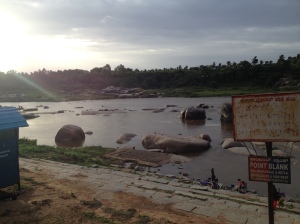
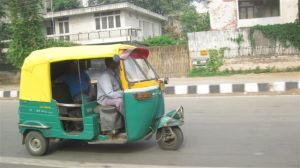
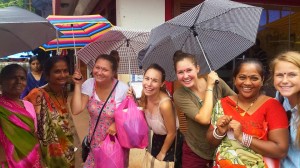


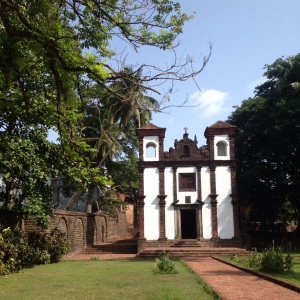

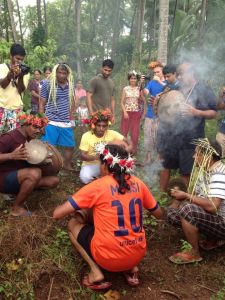

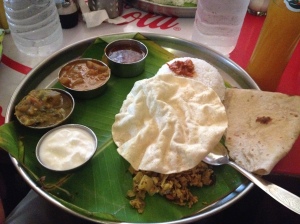
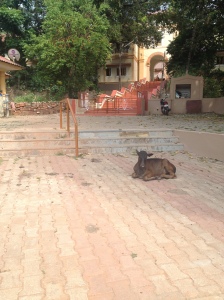


No comments.
Comments are currently closed. Comments are closed on all posts older than one year, and for those in our archive.